|
|
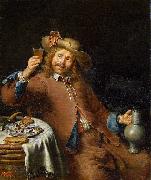 |
Pieter Cornelisz. van Slingelandt
|
|
(20 October 1640 - 7 November 1691) was a Dutch Golden Age painter.
According to Houbraken, his teacher was Gerard Dou, who he imitated so well that many of his works were later misattributed to him. According to Houbraken he was rather introverted and very methodical and conscientious, spending months on his works and striving for perfection. Houbraken especially liked a piece where a maid holds a mouse by the tail as a cat jumps for it.
Houbraken wrote that while Slingelandt was working on a family portrait for the gentleman Francois Meerman (1630-1672), |
|
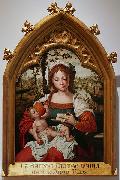 |
Pieter van Aelst
|
|
(August 14, 1502 - December 6, 1550) was a Flemish painter. He studied under Bernaert van Orley and later lived in Italy before entering the Antwerp Guild of painters in 1527. In 1533, he travelled to Constantinople for one year in a failed attempt to establish business connections for his tapestry works. Van Aelst established a studio in Brussels in 1544, where he created paintings and tapestries. His students include Gillis van Coninxloo, Willem Key, Hans Vredeman de Vries, Michiel Coxcie, and possibly Pieter Brueghel the Elder, who did eventually marry van Aelst's daughter, Mayken. His second wife, Mayken Verhulst, was an artist as well, and, according to Carel van Mander, the first teacher of her grandchildren, Pieter Brueghel the Younger and Jan Brueghel the Elder. He was also the uncle of Joachim Bueckelaer. Van Aelst's studio is also well known for its engraved works.
In particular, van Aelst is noted for his 1539 translation of Sebastiano Serlio's architectural treatise, Architettura, which is credited with having played a crucial role in spreading Renaissance ideas to the Low Countries and hastening the transition from the late Gothic style prevalent in the area at the time. He was in charge of the spectacular decorations for the 1549 Royal entry into Antwerp of Philip II of Spain, "the most famous entry of the century", according to Roy Strong.
|
|
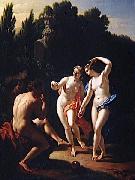 |
Pieter van der Werff
|
|
(1665 - September 26, 1722) was a Dutch Golden Age painter. He assisted his older brother, Adriaen van der Werff.
He learned to paint from his brother Adriaen and according to the RKD, he spent most of his life working in Rotterdam, where he painted the rich and famous |
|
|
|
|
|
|
|
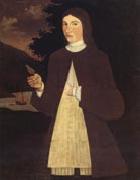 |
Pieter Vanderlyn
|
|
Dutch-born American Colonial Era Painter, ca.1687-1778
American colonial painter, b. Holland. He reached New York c.1718 and became a portrait painter and land speculator and practiced other trades, settling in Kingston, N.Y. The portrait most certainly ascribed to him is that of Mrs. Petrus Vas, his mother-in-law. John Vanderlyn was his grandson. |
|
 |
Pietro della Vecchia
|
|
(1603 - 8 September 1678) was an Italian painter also known as Pietro Muttoni. Born in Vicenza (Venice), he likely trained with Alessandro Varotari, called Padovanino, deriving a notable interest in Venetian masters such as Titian and Giorgione. Until 1984, he was mistakenly referred to as Pietro Muttoni. This misnomer is attributed to Italian art historian and archaeologist, Luigi Lanzi (June 14, 1732 - 30 March 1810), who in his Storia pittorica della Italia confused the name of the artist with the name of a collection, Muttoni, in which he had seen one of his paintings. In fact, Pietro was from the well known Venetian family, the della Vecchia. Renowned among his contemporaries for his ability to imitate the styles of 16th-century masters, he was also known for his grotesque paintings and portraiture. His earliest known works, two representations of St Francis, which have survived in many versions (e.g. Modena, Gal. Estense; Rovigo, Accad. Concordi), and a Crucifixion (1633; Venice, S Lio) are so heavily influenced by Carlo Saraceni and his student and collaborator Jean Leclerc as to suggest that della Vecchia trained with them. Certain Caravaggesque elements, which remained in his work for some time to come, suggest that he spent some time in Rome after Leclerc had left Venice, in 1621 or 1622. The influence of Alessandro Varotari or Padovanino, who is described by sources (e.g. Orlandini) as della Vecchia's teacher, is only noticeable in dated works from 1635 onwards. Della Vecchia probably worked in Padovanino's studio c. 1625-6, after his trip to Rome, and from the latter he derived his great interest in 16th-century painting in Venice and the Veneto. His monumental Crucifixion (1637; Venice, Fond. Cini), in which the composition harks back to the 16th century while the figures derive from Caravaggio, is characteristic of this phase. Around 1640 the influence of Bernardo Strozzi is apparent in his work, as in the Angel Offering a Skull to St Giustina, who stands between St Joseph and St John (1640; Venice, Accad.), painted for the church of S Giustina. In 1640 he began to design cartoons for the mosaics in S Marco, on which he worked until 1673. From 1640 to 1673 he was commissioned from the Venetian Republic for the design of the mosaic cartoons for the St. Mark's Basilica. He painted four idyllic landscapes that presage some of the Rococo content (now in Pinacoteca Querini-Stampalia). He married Clorinda Renieri, daughter of Nicolas Regnier, Flemish painter and art dealer. Della Vecchia died in Venice, September 1678.
|
|
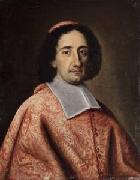 |
Pietro Paolo Vegli
|
|
Pietro Paolo Vegli - Ritratto Del Cardinale Francesco Maidalchini (1621 - 1700)
|
|
|
|
|
|
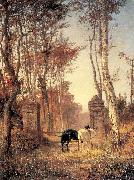 |
Polenov, Vasily
|
|
Russian, 1844-1927
He began a systematic study of drawing in 1856, first with the landscape painter Pavel Cherkasov (1834-1900), then from 1859 to 1861 with Pavel Chistyakov (1832-1919). He also took lessons with Chistyakov, whom he considered his most important teacher, in 1871 and early 1872, after finishing his academic course. From 1863 to 1871 Polenov studied at the St Petersburg Academy of Art, where he met members of the progressive wing of the Russian artistic intelligentsia, and occasionally in the faculty of law at St Petersburg University. The classical education he received at home, his academic training and lessons with Chistyakov led Polenov towards an 'exalted' history painting, although he personally inclined towards landscape. This dualism remained in Polenov's work for the duration, and not until the late 1880s and early 1890s did he achieve a stable relationship between the two forms. The whole of his student career and the initial postgraduate, scholarship period was largely taken up with historical works: from academic compositions, for example the Resurrection of Jairus's Daughter (1871; Pskov, Mus. Hist., Archit. & A.), for which he received the Grand Gold Medal and a travel bursary (in Germany and Italy, 1872-3, and France, 1873-6), to numerous pictures and sketches on subjects from antiquity and medieval history, executed in France or shortly after his departure from there, under the perceptible influence of Paul Delaroche |
|
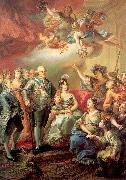 |
Portana, Vicente Lopez
|
|
Spanish Painter, 1772-1850
was a Spanish painter, considered the best portrait painter of his time. Vicente Lepez y Portaña was born in Valencia on September 19, 1772. His parents were Cristebal Lepez Sanchordi and Manuela Portaña Meer. Vicente Lepez began formally studying painting in Valencia at the age of thirteen, he was a disciple of father Antonio de Villanueva, a Franciscan monk, and he studied at the Academy of San Carlos in his native city. He was seventeen when he won first price in drawing and coloring receiving a scholarship to study in the prestigious Academia Real de Bellas Artes de San Fernando in Madrid. For the following three years in Madrid, he apprenticed with the Valencian painter, Mariano Salvador Maella. Vicente Lepez returned to Valencia in 1794 and subsequently became vice-director of painting at the Academy where he had studied as a boy. |
|
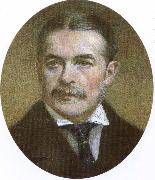 |
queen victoria
|
|
Born: 24 May 1819
Birthplace: London, England
Died: 22 January 1901 (cerebral hemorrhage)
Best Known As: The queen who reigned for 64 years |
|
|
|
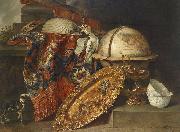 |
R. v. Bohnlich
|
|
R v Bohnlich (fl.c.1880)
19th Century Paintings and Watercolours
|
|
 |
Raja Ravi Varma
|
|
1848-1906, Indian painter. He was the most important and one of the earliest Indian artists of the 19th century to work in oil paints. The subjects of his paintings were often mythological, but they were produced in a European historicist style. He absorbed the influence of such French 19th-century academic painters as William-Adolphe Bouguereau and Gustave Boulanger and of Indian contemporary popular theatre, specializing in the type of mythological paintings that found favour with Indian rajas and British administrators. His successful exploitation (from 1894) of the lithographic reproduction of his paintings ensured, for the first time in India, that the work of an individual artist could reach a mass market. |
|
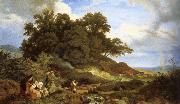 |
ralph vaughan willams
|
|
Period: Romantic (1820-1869)
Country: Germany
Born: February 03, 1809 in Hamburg, Germany
Died: November 04, 1847 in Leipzig, Germany |
|
|
|
|
|
 |
Rembrandt Harmensz Van Rijn
|
|
b. 1606 Leiden, The Netherlands, d. 1669 Amsterdam,Dutch painter, draughtsman and etcher. From 1632 onwards he signed his works with only the forename Rembrandt; in documents, however, he continued to sign Rembrandt van Rijn (occasionally van Rhyn), initially with the addition of the patronymic 'Harmensz.'. This was no doubt in imitation of the great Italians such as Leonardo, Michelangelo, Raphael and Titian, on whom he modelled himself, sometimes literally. He certainly equalled them in fame, and not only in his own country. His name still symbolizes a whole period of art history rightfully known as 'Holland's Golden Age'. In 1970-71 a great exhibition in Paris was devoted to it under the eloquent title Le Si?cle de Rembrandt. A century before, a popular work of cultural history by C. Busken Huet referred to the Netherlands as 'the land of Rembrandt'. His fame is partly due to his multi-faceted talent. Frans Hals was perhaps at times a greater virtuoso with the brush but remained 'only' a portrait painter. Vermeer may have excelled Rembrandt in the art of illusion but was less prolific. Rembrandt was not only a gifted painter but also an inspired graphic artist: he has probably never been surpassed as an etcher, and he often seems inimitable as a draughtsman. His subjects reflect his manifold talent and interests. He painted, drew and etched portraits, landscapes, figures and animals, but, above all, scenes of biblical and secular history and mythology. |
|
 |
Rembrandt van rijn
|
|
1606-1669
Dutch painter, draughtsman and etcher. From 1632 onwards he signed his works with only the forename Rembrandt; in documents, however, he continued to sign Rembrandt van Rijn (occasionally van Rhyn), initially with the addition of the patronymic 'Harmensz.'. This was no doubt in imitation of the great Italians such as Leonardo, Michelangelo, Raphael and Titian, on whom he modelled himself, sometimes literally. He certainly equalled them in fame, and not only in his own country. His name still symbolizes a whole period of art history rightfully known as 'Holland's Golden Age'. In 1970-71 a great exhibition in Paris was devoted to it under the eloquent title Le Si?cle de Rembrandt. A century before, a popular work of cultural history by C. Busken Huet referred to the Netherlands as 'the land of Rembrandt'. His fame is partly due to his multi-faceted talent. Frans Hals was perhaps at times a greater virtuoso with the brush but remained 'only' a portrait painter. Vermeer may have excelled Rembrandt in the art of illusion but was less prolific. Rembrandt was not only a gifted painter but also an inspired graphic artist: he has probably never been surpassed as an etcher, and he often seems inimitable as a draughtsman. His subjects reflect his manifold talent and interests. He painted, drew and etched portraits, landscapes, figures and animals, but, above all, scenes of biblical and secular history and mythology. |
|
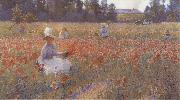 |
Robert William Vonnoh
|
|
American portrait and landscape painter, 1858-1933
was an American Impressionist painter known for his portraits and landscapes. |
|
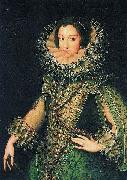 |
Rodrigo de Villandrando
|
|
Rodrigo de Villandrando (1588 - December 1623) was a court painter during the reign of Philip III of Spain. He worked in the tradition of Alonso Senchez Coello and Juan Pantoja de la Cruz. His death opened the road to court for the young painter Diego Velezquez from Sevilla. |
|
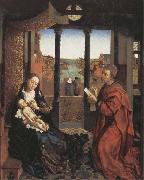 |
Roger Van Der Weyden
|
|
c.1399-1464
Rogier van der Weyden was the son of Henri de le Pasture, a cutler in Tournai, and Agn?s de Watreloz. His birthdate is estimated from the facts that he was stated to be 35 in April 1435 and 43 in September 1441. Before or in 1427 he married Elisabeth Goffaert (c. 1405-77), whose father was a prosperous shoemaker in Brussels. Rogier may have lived for a time in Brussels: his eldest child Cornelis (b 1427) was sometimes referred to as 'de Bruxella' but was not necessarily a native of Brussels. On 5 March 1427 'Rogelet de le Pasture, natif de Tournai' was apprenticed to the Tournai painter Robert Campin. This Rogelet duly completed his apprenticeship in 1431 and on 1 August 1432 became a master of the Tournai guild. Despite much debate, it would appear that Rogelet was Rogier van der Weyden, though it has also been argued that in 1427 Rogier was a married man well past the normal age of apprenticeship and that Rogelet must have been a second Tournai painter of the same name. JACQUES DARET, however, was in his twenties when in 1428 he was apprenticed to Campin, and other instances can be cited of married apprentices. The political situation at Tournai in 1427-8 was unusual, and the guild system was not functioning normally. |
|
 |
Rogier van der Weyden
|
|
Rogier van der Weyden 1399/1400 - 1464 was the most important representative of Netherlandish painting or Northern Renaissance ... is, with Jan van Eyck, considered one of the greatest exponents of the school of Early Netherlandish painting. Rogier van der Weyden was born in Tournai as 'Rogier de le Pasture' (Roger of the Pasture) in 1399 or 1400. His parents were Henri de le Pasture and Agnes de Watr??los. The family had settled before in the city of Tournai where Rogiers father worked as a 'maître-coutelier' (knife manufacturer). In 1426 Rogier married Elisabeth, the daughter of the Brussels shoemaker Jan Goffaert and his wife Cathelyne van Stockem. Rogier and Elisabeth had four children: Cornelius, who became a Carthusian monk, was born in 1427, a daughter Margaretha in 1432. Before 21 October 1435 the family settled in Brussels where the two younger children were born: Pieter in 1437 and Jan the next year. From the second of March 1436 onwards held the title of 'painter to the town of Brussels' (stadsschilder) a very prestigious post because Brussels was at that time the most important residence of the splendid court of the Dukes of Burgundy. It was at the occasion of his move to the Dutch-speaking town of Brussels that Rogier began using the Dutch version of his name: 'Rogier van der Weyden'Little is known about Rogier's training as a painter. The archival sources from Tournai (completely destroyed during World War II, but luckily partly transcribed in the 19th and early 20th century) are somewhat confusing and have led to different interpretations by scholars. From a document it is known that the city council of Tournai offered wine in honour of a certain 'Maistre Rogier de le Pasture' on March the 17th 1427. However, on the 5th of March of the following year the records of the painters' guild show a certain 'Rogelet de le Pasture' entered the workshop of Robert Campin together with Jacques Daret. Only five years later, on the first of August 1432, Rogier de le Pasture obtains the title of 'Master' (Maistre) as a painter.[1] Many have doubted whether Campin's apprentice 'Rogelet' was the same as the master 'Rogier' that was offered the wine back in 1426. The fact that in 1426-1427 Rogier was a married man in his late twenties, and well over the normal age of apprenticeship has been used as an argument to consider 'Rogelet' as a younger painter with the same name. In the 1420's however the city of Tournai was in crisis and as a result the guilds were not functioning normally. The late apprenticeship of Rogier/Rogelet may have been a legal formality. Also Jacques Daret was then in his twenties and had been living and working in Campin's household for at least a decade. It is possible that Rogier obtained an academic title (Master) before he became a painter and that he was awarded the wine of honour on the occasion of his graduation. The sophisticated and 'learned' iconographical and compositional qualities of the paintings attributed to him are sometimes used as an argument in favour of this supposition. The social and intellectual status of Rogier in his later life surpassed that of a mere craftsman at that time. In general the close stylistical link between the documented works of Jacques Daret, and the paintings attributed to Robert Campin and Rogier van der Weyden is considered as the main argument to consider Rogier van der Weyden as a pupil of Robert Campin. The last mention of Rogier de la Pasture in the financial records of Tournai, on October 21, 1435, lists him as demeurrant ?? Brouxielles ('living in Brussels'). At the same time, the first mention of Rogier de Weyden is made as the official painter of Brussels. Therefore Rogier de la Pasture and Rogier Van der Weyden are thought to be one and the same painter. The post of city painter was created especially for Van der Weyden and was meant to lapse on his death. It was linked to a huge commission to paint four justice scenes for the 'Golden Chamber' of Brussels City Hall.[2] Different properties and investments are documented and witness his material prosperity. The portraits he painted of the Burgundian Dukes, their relatives and courtiers, demonstrate a close relationship with the elite of the Netherlands. The Miraflores Altarpiece was probably commissioned by King Juan II of Castile, since Juan II donated it to the monastery of Miraflores in 1445. |
|
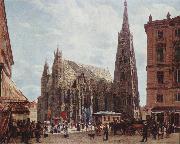 |
Rudolf von Alt
|
|
(28 August 1812 in Vienna C 12 March 1905 in Vienna) was an Austrian landscape and architectural painter. Borne as Rudolf Alt, he could call himself von Alt and bear the title of a Ritter (knight) after he gained nobility in 1882.
He was the son of the famous lithographer Jakob Alt (1789-1872). He studied at the Akademie der bildenden K??nste in Vienna. Hiking-trips through the Austrian Alps and northern Italy awoke a love for landscapes, and he painted with his brush using watercolors in a very realistic and detailed style. In 1833, inspired by a visit to Venice and neighbouring cities, he also made a number of architectural paintings.
Alt demonstrated a remarkable talent for expressing certain peculiarities in nature. He managed to paint nature authentically by focusing on the different hues of sky, the colour-tone of the air and the vegetation. His later works came closer to Impressionism. His perspectives on architecture were interesting, and he often chose everyday objects to paint. The painting of interior-views also became one of his strong points, giving him attention in Vienna. |
|
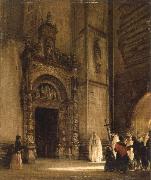 |
rudolph von alt
|
|
Rudolf Ritter von Alt (28 August 1812 in Vienna ?C 12 March 1905 in Vienna) was an Austrian landscape and architectural painter. Borne as Rudolf Alt, he could call himself von Alt and bear the title of a Ritter (knight) after he gained nobility in 1882.
He was the son of the famous lithographer Jakob Alt (1789-1872). He studied at the Akademie der bildenden K??nste in Vienna. Hiking-trips through the Austrian Alps and northern Italy awoke a love for landscapes, and he painted with his brush using watercolors in a very realistic and detailed style. In 1833, inspired by a visit to Venice and neighbouring cities, he also made a number of architectural paintings.
Alt demonstrated a remarkable talent for expressing certain peculiarities in nature. He managed to paint nature authentically by focusing on the different hues of sky, the colour-tone of the air and the vegetation. His later works came closer to Impressionism. His perspectives on architecture were interesting, and he often chose everyday objects to paint. The painting of interior-views also became one of his strong points, giving him attention in Vienna.
He visited and worked for a while in Rome and Naples; after that he visited the lakes of Lombardy, then Galicia, Bohemia, Dalmatia, Bavaria and then returned multiple times to Italy. In 1863 he went to the Crimea to paint some views of an estate of the Empress, and in 1867 he went to Sicily.
His younger brother Franz Alt, (b. 1821 in Vienna) was also a painter.
Most of his paintings are held by various museums in Vienna. The Albertina in Vienna hosted a retrospective exhibition from September 2005 to January 2006.
|
|
|
|
|
|
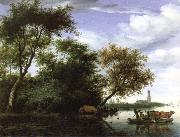 |
Salomon van Ruysdael
|
|
Salomon van Ruysdael (c. 1602, Naarden - buried Nov 3, 1670, Haarlem) was a Dutch landscape painter. He was the uncle of Jacob van Ruisdael. |
|
|
|
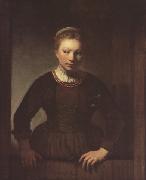 |
Samuel van hoogstraten
|
|
Dutch Baroque Era Painter, 1627-1678
Dutch portrait painter and etcher, studied with his father, Dirk van Hoogstraten (1596?C1640), and with Rembrandt. His best works, such as The Old Jew (Vienna), reflect the influence of Rembrandt. He was director of the Academy in Dordrecht and author of a treatise (1678) in which he analyzed the theory and practice of the art of Rembrandt and other artists of the period. |
|
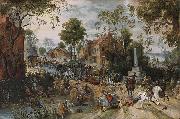 |
Sebastiaen Vrancx
|
|
(22 January 1573 - 19 May 1647) was a Flemish Baroque painter and etcher of the Antwerp school.
He was an apprentice in the workshop of Adam van Noort, who also trained many illustrious painters such as Peter Paul Rubens, Jacob Jordaens and Hendrik van Balen. He also visited the workshop of the Antwerp painter Paul Bril in Rome around 1600.
He was esteemed as one of the main painters of battle scenes, and works by Vranckx were in the collection of Peter Paul Rubens. As a collaborator he worked at times with Jan Brueghel the Elder. and together with Rubens, Frans Francken the Younger, van Balen, Frans Snyders and Joos de Momper the Younger on the Allegory of the Senses, two works commissioned on the occasion of the archduke Albert of Austria's visit to Antwerp. His best-known student is Pieter Snayers.
Most of his pictures represent biblical scenes or scenes of war, such as the sack of towns, cavalry combats, genre paintings and allegorical subjects. Though occasionally vigorous in drawing, his paintings are dull and heavy in tone.
He was at the same time a writer of poetry, comedies and tragicomedies for the chamber of rhetoric De Violieren. He was served as dean of the Antwerp painters' Guild of St. Luke, and was a district head and captain of the militia.
His works can be found in the Royal Museum of Fine Arts in Antwerp, Groeninge Museum in Bruges (both in Belgium) and the Noordbrabants museum in 's-Hertogenbosch and the Rijksmuseum in Amsterdam (the Netherlands). He is also represented with several drawings or paintings at the Hermitage in Saint Petersburg, the Harvard University Art Museums, the Louvre, Paris and several other museums.
|
|
 |
Sebastian Vrancx
|
|
Flemish Baroque Era Painter ,
b. 1573, Antwerpen, d. 1647, Antwerpen
Antwerpen,was a Flemish Baroque painter and etcher of the Antwerp school. He was an apprentice in the workshop of Adam van Noort, who also trained many illustrious painters such as Peter Paul Rubens, Jacob Jordaens and Hendrik van Balen. He also visited the workshop of the Antwerp painter Paul Bril in Rome around 1600. He was esteemed as one of the main painters of battle scenes, and works by Vrancx were in the collection of Peter Paul Rubens. As a collaborator he worked at times with Jan Brueghel the Elder. and together with Rubens, Frans Francken the Younger, van Balen, Frans Snyders and Joos de Momper the Younger on the Allegory of the Senses, two works commissioned on the occasion of the archduke Albert of Austria's visit to Antwerp. His best-known student is Pieter Snayers. Most of his pictures represent biblical scenes or scenes of war, such as the sack of towns, cavalry combats, genre paintings and allegorical subjects. Though occasionally vigorous in drawing, his paintings are dull and heavy in tone. He was at the same time a writer of poetry, comedies and tragicomedies for the chamber of rhetoric De Violieren. He was served as dean of the Antwerp painters' Guild of St. Luke, and was a district head and captain of the militia. His works can be found in the Royal Museum of Fine Arts in Antwerp, |
|
|
|
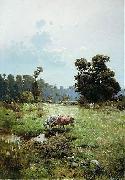 |
Serhii Vasylkivsky
|
|
(October 19, 1854, Izium e October 7, 1917, Kharkiv) was one of the most prolific Ukrainian artists of the pre-revolutionary period and an expert on Ukrainian ornamentation and folk art.
Vasylkivsky grew up in an environment conducive to his development as an artist. He was born and spent his childhood in the picturesque surroundings of Izium, a city in the historical region of Sloboda Ukraine, and today's Kharkiv Oblast. The future painter had a chumak grandfather whose roots reached cossack ancestral lines. Vasylkivsky's father was a writer and taught his son the aesthetics of proper calligraphy. His mother, through her folk songs set the foundation which provided the inspiration for Vasylkivsky's art later in life.
When he was seven years old, his parents moved to Kharkiv, which at the time was a significant cultural center of Sloboda Ukraine. Vasylkivsky's first art lessons were given at the Kharkiv gymnasium by Dmytro Bezperchy, a student of Karl Briullov. During the years of his study, Vasylkivsky was able to use the extensive book collection of his relative and poet, V. Alexandrov. Among these were the works by Ivan Kotlyarevsky, Taras Shevchenko, and Nikolai Gogol, which made a strong impression on the young artist. After five years of education at the gymnasium and at the demand of his father, Vasylkivsky began studies at the Kharkiv Veterinary School. This lasted until 1873, when Vasylkivsky left veterinary studies due to his parents inability to pay for tuition. For a while, he worked as a civil servant in Kharkiv.
|
|
 |
Simon Vouet
|
|
French
Simon Vouet Gallery
1590-1649
French painter and draughtsman. Although at the time regarded as one of the leading French painters of the first half of the 17th century, he is now known more for his influence on French painting than for his actual oeuvre. He made his reputation in Italy, where he executed numerous portraits for aristocratic patrons and was commissioned for religious subjects. Although the early Italian works show the influence of Caravaggio, his work was subsequently modified by the Baroque style of such painters as Lanfranco and the influence of the Venetian use of light and colour. When he was summoned back to France by Louis XIII in 1627 he thus brought with him an Italian idiom hitherto unknown in France that revitalized French painting.
|
|
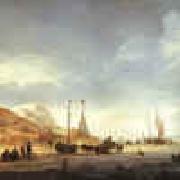 |
Simon de Vlieger
|
|
Dutch
1600-1653
Dutch painter, draughtsman, etcher and stained-glass designer. He was one of the leading marine and landscape artists of the Dutch school and decisively influenced the direction of Dutch marine art during the 1630s and 1640s. His late works anticipated the shift from the monochrome or tonal phase of Dutch marine art to the more classical style of Jan van de Cappelle and Willem van de Velde the younger (see MARINE PAINTING). Although de Vlieger reputation rests chiefly on his marine paintings, he was also a notable draughtsman and etcher.
|
|
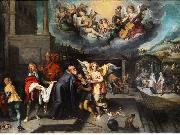 |
Simon de Vos
|
|
Simon de Vos (Antwerp, 20 October 1603-15 October 1676, Antwerp) was a Flemish Baroque painter of genre and cabinet pictures.
De Vos studied with Cornelis de Vos (1603-76), to whom he is not related, from 1615 until 1620. In 1620 he joined Antwerp's guild of St. Luke, and then he probably travelled to Rome where he came under the influence of the "low-life" genre paintings of the Bentvueghels and the bambocciate. A Caravaggesque influence, by way of the German painter Johann Liss active in Italy during the 1620s is discernible in De Vos's paintings from this time on. In contrast to the earlier "low-life" paintings, works from the late 1620s until around 1640, which were made after returning to Antwerp, are mostly small "merry company" and courtly genre scenes reminiscent of contemporary Dutch painters Dirck Hals and Pieter Codde. After 1640, De Vos turned away from genre scenes altogether and painted mostly small cabinet paintings of history subjects, influenced stylistically at first by Peter Paul Rubens and then increasingly by Anthony van Dyck. Examples include The Beheading of St. Paul (1648) in the Royal Museum of Fine Arts, Antwerp.
He married Catharina van Utrecht, the sister of Adriaen van Utrecht, in 1628. |
|
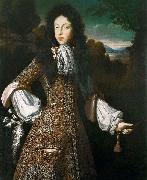 |
Simon Pietersz Verelst
|
|
(1644, The Hague - 1710, London), was a Dutch Golden Age painter.
According to the RKD he was the son of Pieter Harmensz Verelst and became a pupil in the Confrerie Pictura at the same time as his brother Herman in 1663. In 1668 he moved to London and called himself "the God of Flowers", but is known for portraits as well as flower and fruit still life paintings. |
|
|
|
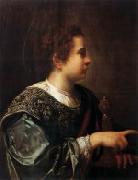 |
Simon Vouet
|
|
b. 1590, Paris, d. 1649, Paris.French painter and draughtsman. Although at the time regarded as one of the leading French painters of the first half of the 17th century, he is now known more for his influence on French painting than for his actual oeuvre. He made his reputation in Italy, where he executed numerous portraits for aristocratic patrons and was commissioned for religious subjects. Although the early Italian works show the influence of Caravaggio, his work was subsequently modified by the Baroque style of such painters as Lanfranco and the influence of the Venetian use of light and colour. |
|
|
|
|
|
 |
Stefano da Verona
|
|
Stefano da Verona. Dating to 1434, it is currently housed in the Pinacoteca di Brera of Milan, northern Italy.
|
|
|
|
|
|
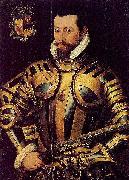 |
Steven van der Meulen
|
|
(b. eAntwerp - d. London, e1563-64) was a Dutch artist active c. 1543-1564. He gained prominence in England in the first decade of the reign of Elizabeth I as one of many Flemish artists active at the Tudor court. He is best known for the "Barrington Park" portrait type of Elizabeth I and for three-quarter length portraits of members of the English court in the first half of the 1560s. A recently discovered will indicates that he died in London between October 1563 and January 1564.
|
|
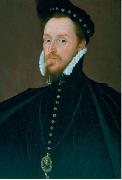 |
Steven van Herwijck
|
|
(Utrecht c. 1530-London 1565/67), was a Netherlandish sculptor and gem engraver famous for his portrait medallions and medals. It has recently been suggested that he is the "famous paynter Steven" mentioned in an inventory of 1590, who has traditionally been identified as Steven van der Meulen.
Van Herwijck worked in Italy in 1557 and returned to Utrecht in 1558, when he was made a Master of the artists' Guild of St. Luke. His earliest surviving medals, of George van Egmond, Bishop of Utrecht, and Engelken Tols, date from this year. In 1559 he relocated to Antwerp. Nine medals survive of his work there, including a portrait of Jacobus Fabius. Fleeing religious persecution, he went to Poland in 1561 where he made medallions of King Sigismund II and other members of the Polish royal family. |
|
|

